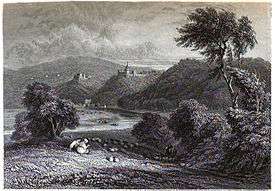Goodrich Court

Goodrich Court was a 19th-century, neo-gothic castle built by the antiquarian Sir Samuel Rush Meyrick in Goodrich, Herefordshire in 1828. Except for the gatehouse, it was demolished in 1949.
History
Samuel Meyrick was an antiquarian with an interest in Welsh history who claimed, incorrectly, to be related to the Welsh prince Owain Gwynedd. Meyrick desired a Welsh castle as his ancestral home, but was unable to acquire one.[1] Instead he decided to build his own new castle alongside the ruined castle at Goodrich Castle, near to the Welsh border, which he called Goodrich Court. Architectural historian Nikolaus Pevsner called it a "fantastic and enormous castellated tower-bedecked house", whilst its siting, directly opposite the genuine Norman castle, a positioning which foreshadowed that of Peckforton Castle and Beeston Castle, caused Sir Walter Scott to condemn it as "impertinent".[2]
Designed by the Gothic Revival architect Edward Blore to Meyrick's instructions, Goodrich Court was built of local red sandstone in the neo-gothic style, and although based on the Edwardian architecture seen at Goodrich Castle,[3] to some it more resembled a French chateaux.[4] Enjoying a gatehouse, portcullis, battlements, a moat and towers,[5] it was also noted for the Armoury, a large hall which contained Meyrick's famous collection of armour.[6] Many of the details of the castle utilised the heraldic symbols of Alymer de Valence, a medieval lord at Goodrich Castle in the early 14th century.[7]

After Meyrick's death in 1848, Goodrich Court was bought by George Moffatt, a Liberal party Member of Parliament. The Moffatts extended the castle, including building new stables in the same style as the original property. During the Second World War the castle was used by Felsted School, which was evacuated from Essex to the area. When the school relocated back to Felsted, the castle was stripped of its fittings in 1946 and demolished in 1949.[8] The East gatehouse, on the road to Ross-on-Wye, survives, described by Pevsner as "red stone with round towers and machicoulis."[2]
The site of the building is now a nature reserve.
Bibliography
- Harris, John. (2007) Moving Rooms: the Trade in Architectural Salvages. Yale University Press.
- Parley, Peter. (2008) Tales about England, Scotland, Ireland and Wales. General Books LLC
- Pevsner, Nikolaus. (2003) The Buildings of England: Herefordshire: Yale University Press.
- Roscoe, Thomas and Charles Meredith. (1844) Wanderings and excursions in South Wales with the scenery of the river Wye. London: Longman.
Further reading
- Lowe, Rosalind. (2003) Sir Samuel Meyrick and Goodrich Court. Logaston Press.
References
Coordinates: 51°52′44″N 2°37′25″W / 51.879°N 2.6235°W